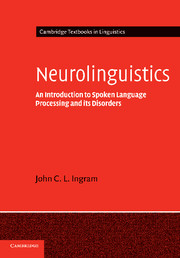Book contents
- Frontmatter
- Contents
- List of figures
- List of tables
- Preface and acknowledgements
- Note on the text
- Part I Foundational concepts and issues
- Part II Speech perception and auditory processing
- Part III Lexical semantics
- Part IV Sentence comprehension
- 12 Sentence comprehension and syntactic parsing
- 13 On-line processing, working memory and modularity
- 14 Agrammatism revisited
- Part V Discourse: language comprehension in context
- Glossary
- References
- Index
13 - On-line processing, working memory and modularity
Published online by Cambridge University Press: 26 January 2010
- Frontmatter
- Contents
- List of figures
- List of tables
- Preface and acknowledgements
- Note on the text
- Part I Foundational concepts and issues
- Part II Speech perception and auditory processing
- Part III Lexical semantics
- Part IV Sentence comprehension
- 12 Sentence comprehension and syntactic parsing
- 13 On-line processing, working memory and modularity
- 14 Agrammatism revisited
- Part V Discourse: language comprehension in context
- Glossary
- References
- Index
Summary
Introduction
In the previous chapter we outlined two opposing theories of the role that syntactic processing plays in sentence comprehension. According to one view – the modular theory, inspired by early psycholinguistic attempts to apply Chomsky's generative grammar – a specialized syntactic parser assigns grammatical structure to an input sentence, yielding an intermediate representation which strongly constrains the assignment of meaning, but which needs to be further operated upon by interpretive (semantic and pragmatic) processes to yield the full meaning of the utterance. According to the opposing view, dubbed the interactive model, sentence meanings are assigned incrementally to word sequences as soon as they are identified, making maximal use of whatever constraints can be applied from the speakers' tacit knowledge of the grammar of their language, pragmatic knowledge and expectations, or even collocational restrictions on word usage (such as habitual phrases or idioms). Sometimes these cues will conflict, in which case constraints may compete to produce local ambiguities which are usually resolved by further input.
In principle, it should be possible to decide between these opposing models (or some intermediate theory between the two) if we had some means of observing changes in state of the language processor as it steps through the input sentence in real time. We may never fully achieve this privileged perspective, but over the past two or three decades a variety of ‘on-line’ techniques, based initially upon behavioural reaction time measurements and latterly upon functional neural imaging techniques, have been devised, which arguably enable us to observe local fluctuations in ‘processing load’, as sentences are judged or comprehended in real time.
- Type
- Chapter
- Information
- NeurolinguisticsAn Introduction to Spoken Language Processing and its Disorders, pp. 266 - 296Publisher: Cambridge University PressPrint publication year: 2007

